Once you make my rich and luxurious Japanese Mayonnaise (Kewpie Mayo) recipe from scratch, you’ll never go back to bottled. You’ll love this wholesome spread that’s savory, tangy, and sweet with a thicker and creamier consistency than regular mayo.
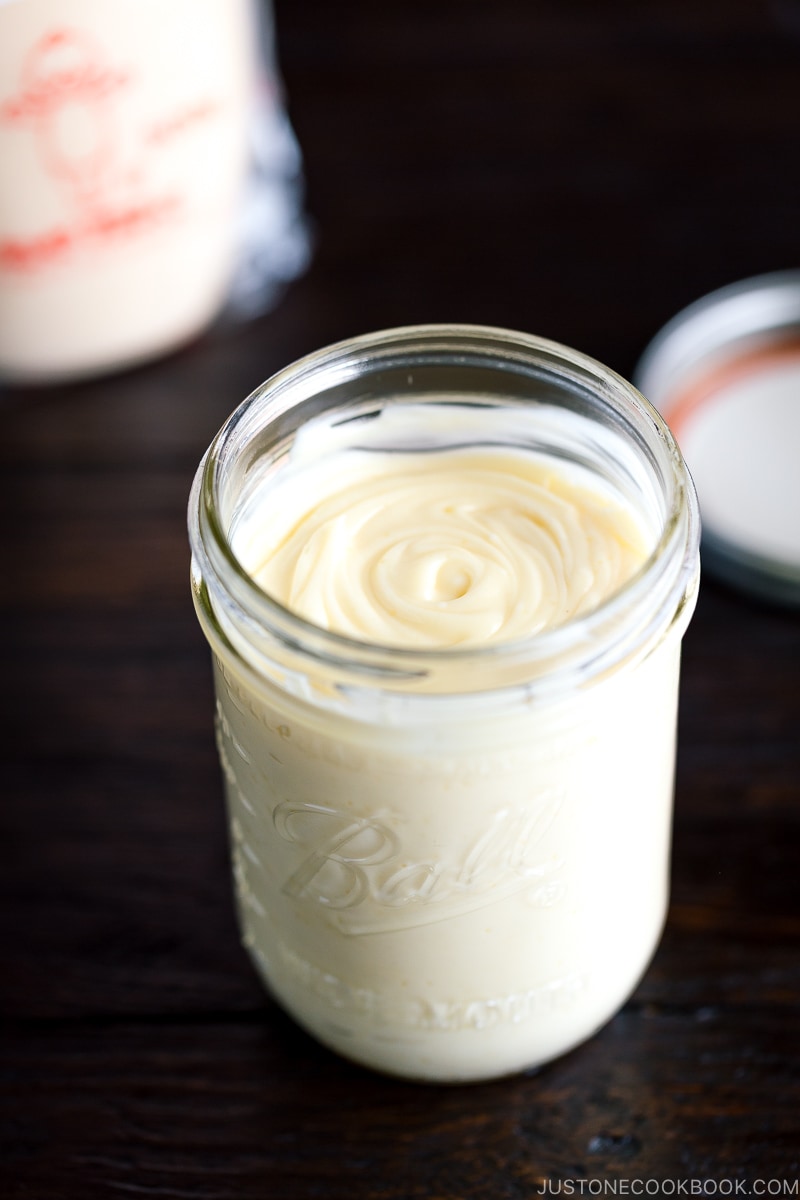
Japanese mayonnaise (マヨネーズ) better known as Kewpie mayo—is a pantry staple in almost every Japanese household. Known for its richer egg flavor and umami goodness, Japanese mayo has become a cult favorite among foodies worldwide. David Chang, the famous chef and founder of the Momofuku restaurant group, even calls it “the best mayonnaise in the world.” I have to agree!
Thanks to its popularity, you can easily find Japanese mayonnaise outside of Japan these days. However, if you wish to make a homemade version, I have two recipes: One is made from scratch, and the other is a short-cut version using ready-made mayonnaise.
Table of contents
What is Japanese Mayonnaise (Kewpie Mayo)?
When most people mention Japanese mayonnaise, they refer to the most popular brand, Kewpie Mayo. It was invented in 1924 by Toichiro Nakashima, who first discovered mayonnaise on his visit to the U.S. and decided to introduce his own mayonnaise so the Japanese people would enjoy it.
Today, Kewpie mayo has become synonymous with Japanese mayonnaise. Everyone recognizes it for its signature squeeze plastic bottle with a Kewpie doll logo and a red cap.
The Japanese are obsessed with this condiment as we use it on sandwiches, okonomiyaki, rice bowls, fusion sushi, salad dressings, and even pizza. In fact, when I was growing up, there were limited choices of dressings, so we used to eat our salad with a dollop of Kewpie mayo (oh, the good old days!)
Many JOC readers told me they were never into American mayo, but they would only use Kewpie mayo as they are enamored by its slightly tangy, creamy, light, yet umami flavor.
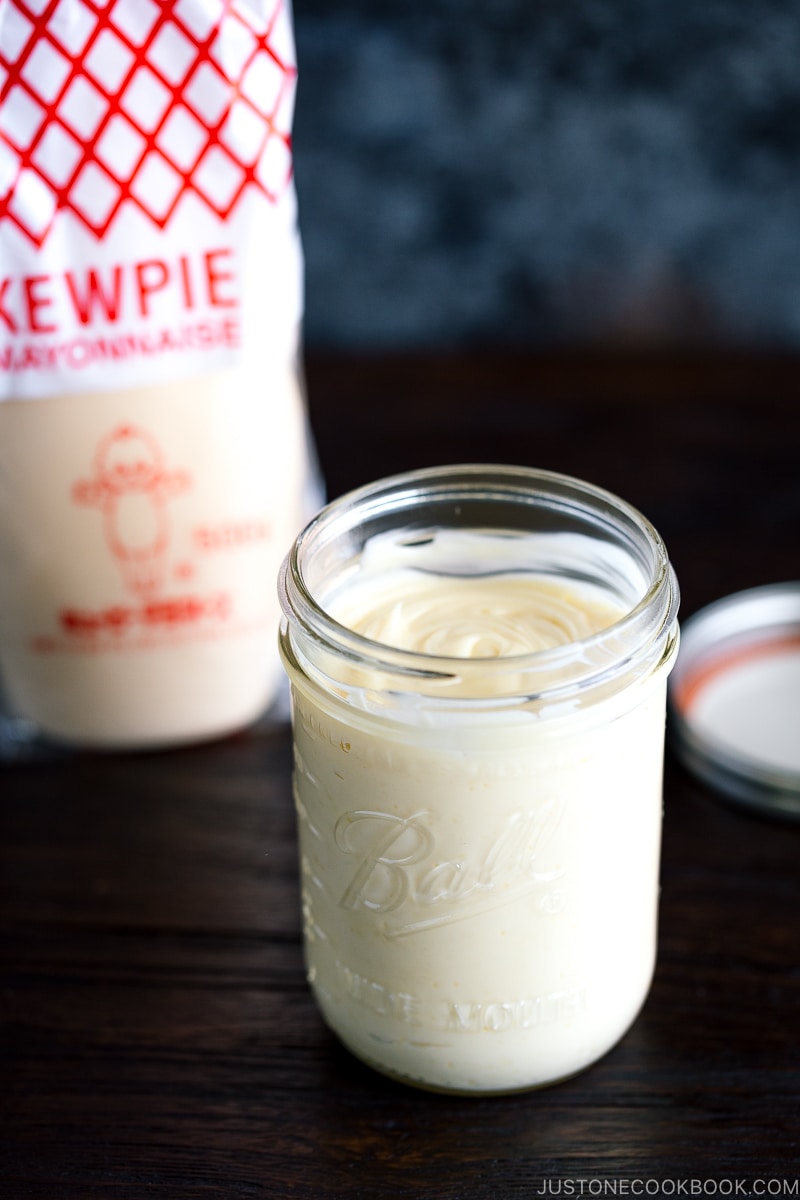
What is the Difference Between Japanese Mayo and Regular Mayo?
So, what is Japanese mayo all about and why is it so famous? How does it taste differently?
You’ll first notice that Japanese mayo has a more prominent eggy taste with a hint of fruity sweetness. The texture is also thicker and creamier than regular mayo.
Japanese mayo uses only egg yolks to create a deeper yellow color and a custard-like texture that is smooth and luxurious, as opposed to regular American mayonnaise, which uses whole eggs. While distilled vinegar is used in American brands, Kewpie incorporates rice vinegar and apple cider vinegar to lend a sweeter and subdued tang.
As the flavor is more rounded and packed with umami, it’s no wonder Kewpie mayo is the must-have ingredient in many iconic Japanese dishes!
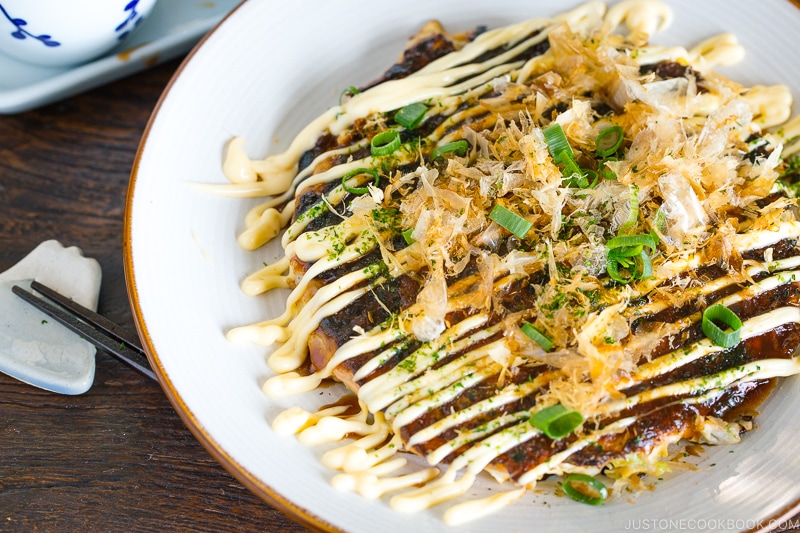
Where to Buy Japanese Mayo
You can find Japanese mayo, especially the Kewpie brand, at most Japanese or Asian grocery stores or online. Some well-stocked mainstream grocery stores such as Costco, Walmart, and Target might carry it too. If you live outside the U.S., you can find it at Daiso (if there’s one near you) or online.
Note that other brands of Japanese mayonnaise are also sold in a plastic squeeze bottle with a fine tip. The unique tip design allows you to spread the mayo on anything and to create zigzag patterns on okonomiyaki (see picture above). Look for the Kewpie doll logo on the bottle if you only want to purchase the Kewpie brand mayo.
Try my homemade mayo if you can’t find it or prefer to make your own!
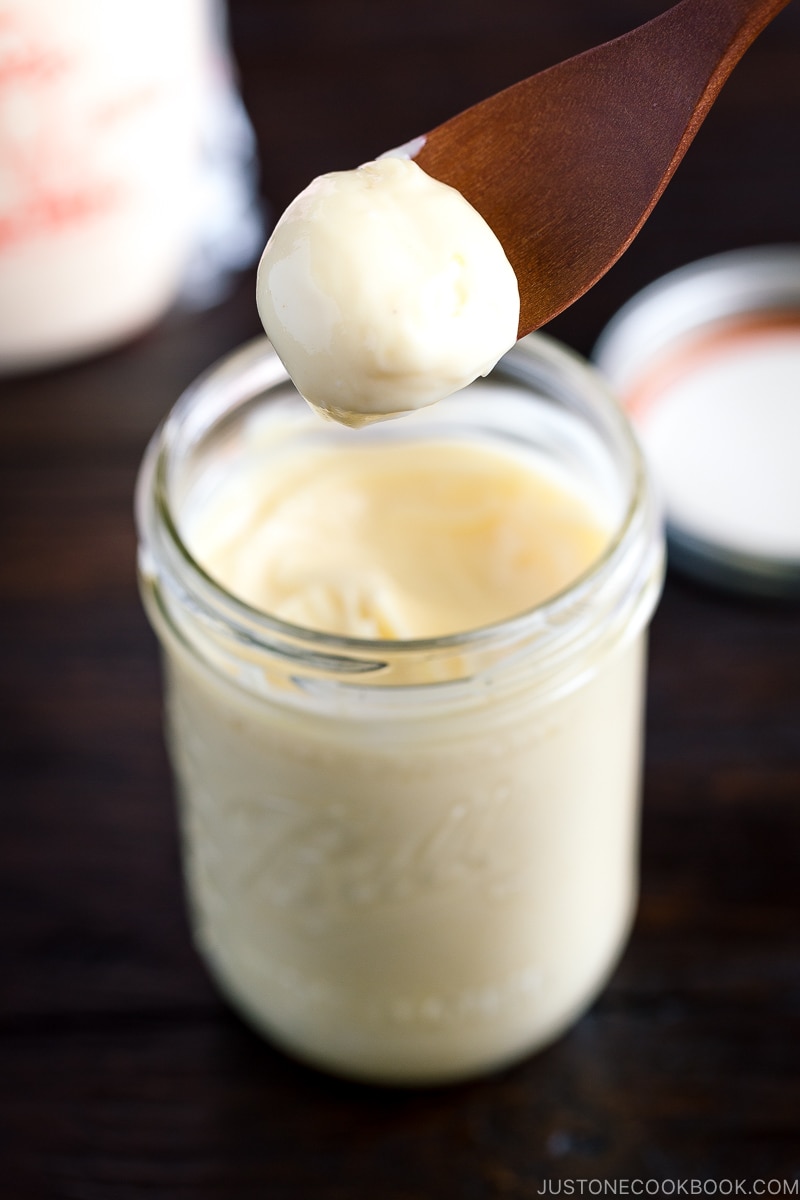
7 Important Tips Before Making Japanese Mayonnaise
Mayonnaise is an emulsion of oil, egg yolk, and vinegar. Oil and water in the yolk are a mixture of two liquids that normally can’t be combined.
Emulsifying is done by slowly adding one ingredient to another while mixing rapidly. This disperses and suspends tiny droplets of one liquid through another. Proteins and lecithin in the egg yolk serve as emulsifiers.
Here are a few tips you need to know:
1. Use vegetable, safflower, grapeseed oil, or canola oil
Never use old oil or extra virgin olive oil, as it won’t emulsify well.
2. Make sure the egg yolks are at room temperature
Molecules in cold egg yolks get separated easily, which makes them less ideal for mixing.
3. Use mustard
Not sure about adding mustard? It’s not included just for the taste but also to further stabilize the emulsion as it contains small amounts of lecithin.
4. Add dashi powder for umami flavor
Kewpie mayo includes monosodium glutamate (MSG), which gives an umami flavor. Since I don’t keep a bag of Ajinomoto (the famous MSG brand) at home, I add dashi powder instead to boost a similar umami flavor. The umami from kombu and Katsuobushi in the dashi powder works in the mayonnaise.
5. Gently pour in the oil in a thin, steady stream
Adding oil too quickly will keep the two liquids from combining (emulsifying); hence, you want to pour the oil into a thin and steady stream when combined with the rest of the mixture.
6. Use a blender, mixer, or food processor
The key to making delicious mayonnaise is how small you make the oil molecules. Store-bought mayonnaise may taste better and lighter because household blender/mixer/food processor is not as powerful as commercial ones.
Still, it’s better to use equipment if you already have one in your kitchen. Using a tool helps churn your homemade mayonnaise much faster and more consistently (less arm work, too).
7. Use pasteurized egg yolks or very fresh egg yolks
Pasteurized eggs can reduce or eliminate the risk of being infected by the salmonella bacteria when preparing recipes that call for raw or uncooked eggs (Roughly one egg out of every 20,000 eggs will contain salmonella). If you have an immersion circulator, you can purchase pasteurized eggs or make your own. Also, the quality of the eggs makes a difference. Use fresh, local organic eggs if possible.
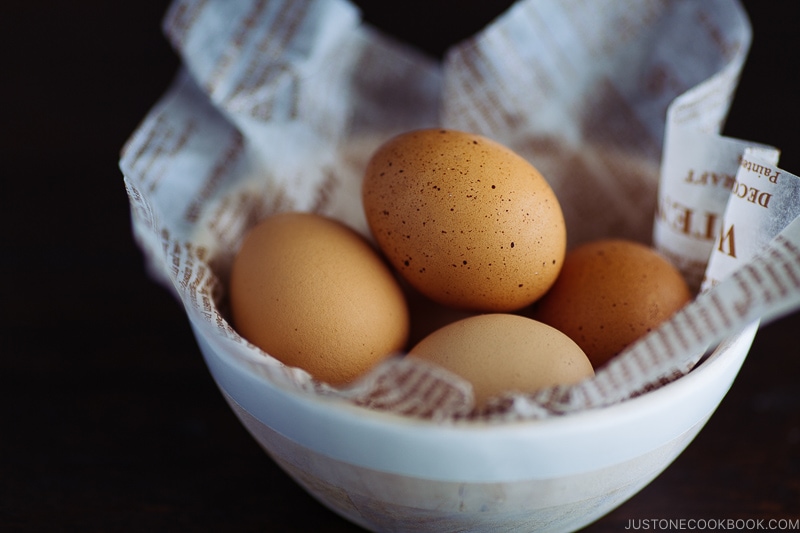
The Easy Version: Quick Japanese Mayo
Not everyone has the time to make homemade mayonnaise from scratch. The good news is you can take a shortcut by adding rice vinegar and sugar to the American mayonnaise. So don’t throw away your Hellmann’s Mayonnaise just yet. It’s not precisely the same, but consider this your easy hack when replicating the taste of Kewpie mayo.
For 1 cup of American mayonnaise, whisk together 2 Tbsp rice vinegar and 1 Tbsp sugar.
For 1 Tbsp of American mayonnaise, whisk together ½ tsp rice vinegar and ⅛ tsp sugar.
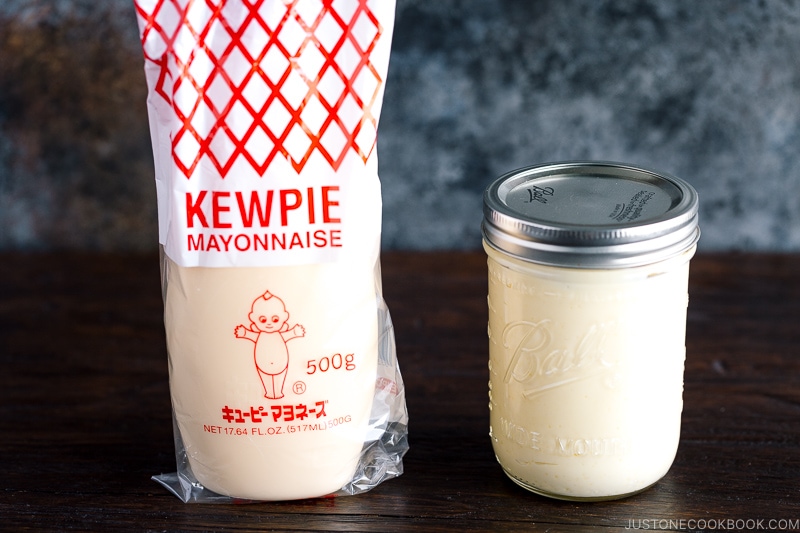
Signature Japanese Recipes Using Japanese Mayo
- Japanese Egg Sandwich (Tamago Sando)
- Takoyaki
- Okonomiyaki
- Karaage
- Japanese Potato Salad
- California Roll
- Japanese Kani Salad
Also, don’t forget to check out my super easy Spicy Mayo recipe! It’s so good in lobster rolls and sushi rolls like dragon rolls.
Wish to learn more about Japanese cooking? Sign up for our free newsletter to receive cooking tips & recipe updates! And stay in touch with me on Facebook, Pinterest, YouTube, and Instagram.
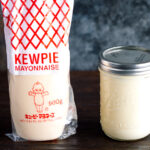
Japanese Mayonnaise (Kewpie Mayo)
Ingredients
- 2 pasteurized egg yolks (at room temperature; from the market, or pasteurize eggs at home)
- 2 tsp Dijon mustard
- 1½ cups neutral oil
- 1 tsp Diamond Crystal kosher salt
- 2 tsp sugar (plus more, to taste)
- ½ tsp dashi powder
- 2 Tbsp rice vinegar (unseasoned)
- 4 tsp fresh lemon juice
Instructions
- Before You Start: This recipe calls for pasteurized egg yolks. If you cannot find them, use the best, freshest eggs you can find. You can also pasteurize them yourself with an immersion circulator; see my tutorial How to Pasteurize Eggs at Home to learn how.
- Gather all the ingredients. Tip: If you reduce the ingredient amounts, there won’t be enough volume for the food processor or blender to do its work, so you may need to hand whisk the ingredients (or use a hand mixer or immersion blender).
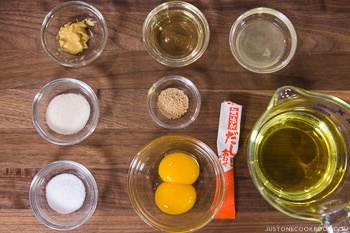
- Make sure the egg yolks are at room temperature. Put 2 pasteurized egg yolks and 2 tsp Dijon mustard into the bowl of a small food processor or a blender; I used a 3-cup food processor for one batch (yields 2 cups) of this recipe. Process for 20 seconds. Tip: Mustard adds flavor and helps to emulsify the mixture, reducing the risk of the mayonnaise breaking.
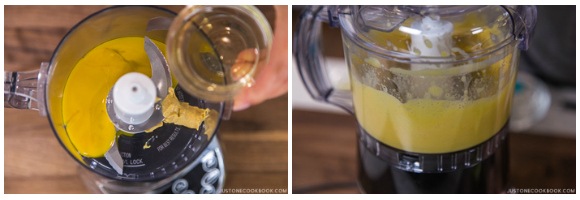
- With the food processor running, SLOWLY drizzle about one-third of the 1½ cups neutral oil in a thin, steady stream—about ½ cup oil for one batch of this recipe. The mixture will begin to thicken and come together. Tip: If you add the oil too fast, it won’t emulsify.
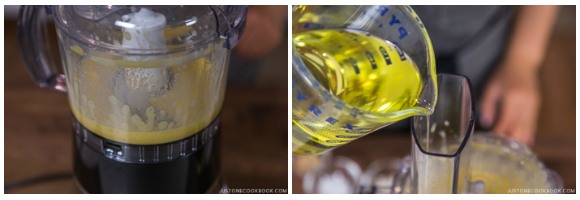
- Add 1 tsp Diamond Crystal kosher salt, 2 tsp sugar, and ½ tsp dashi powder and give everything a whirl again.
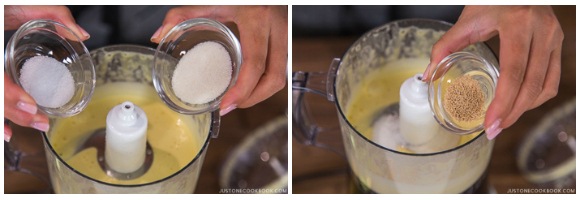
- Continue to slowly drizzle in another one-third of the oil in a thin, steady stream. I use the Stir setting while adding the oil.
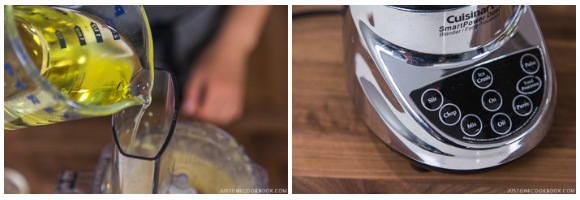
- Finally, add 2 Tbsp rice vinegar (unseasoned) and 4 tsp fresh lemon juice, and slowly drizzle in the remaining one-third of the oil and process for an extra 10 seconds, just until the ingredients are combined and emulsified. Tip: Don’t blend it for too long, as homemade mayonnaise comes together pretty quickly in the food processor or blender. When blended too long, the emulsion that brought the spread together is more likely to break, either from overprocessing or overheating.
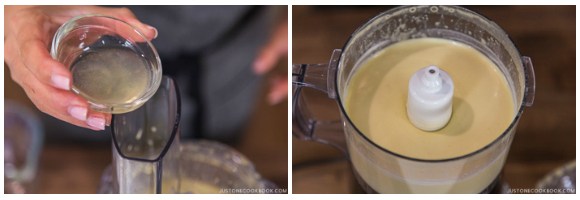
- Taste the mayonnaise and adjust with salt, sugar, or lemon juice to your liking. I personally added 2 more teaspoons of sugar for a total of 4 teaspoons for one batch.
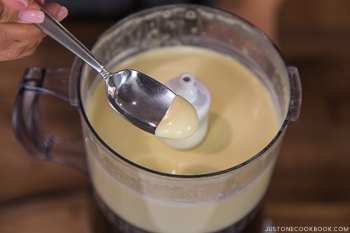
To Store
- You can keep the mayonnaise in an airtight container and store it in the refrigerator for about 4 days.
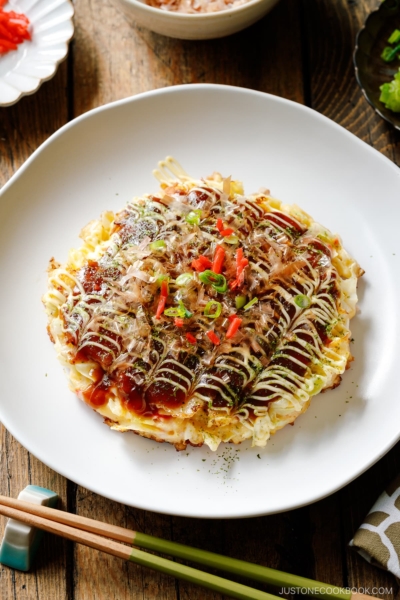
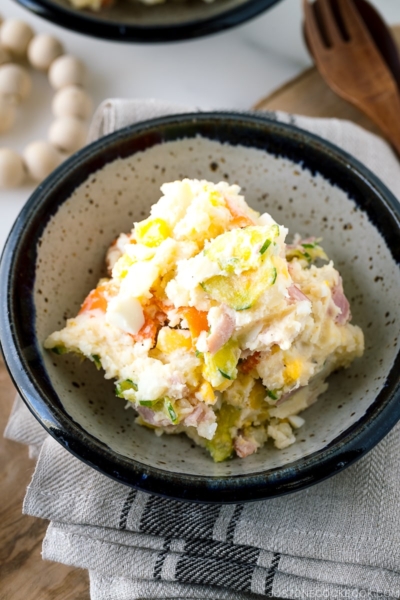
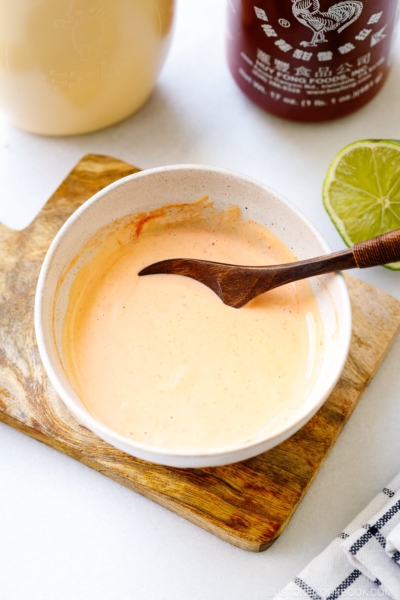
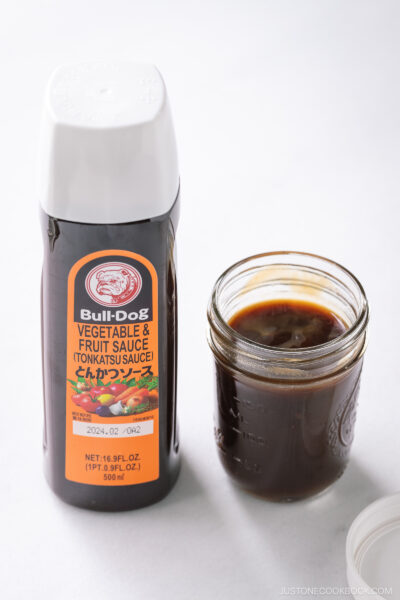
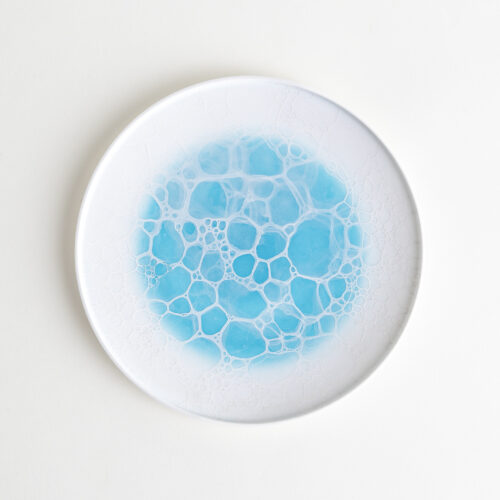
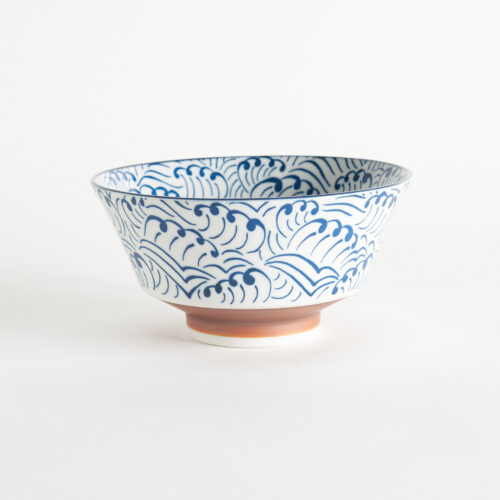

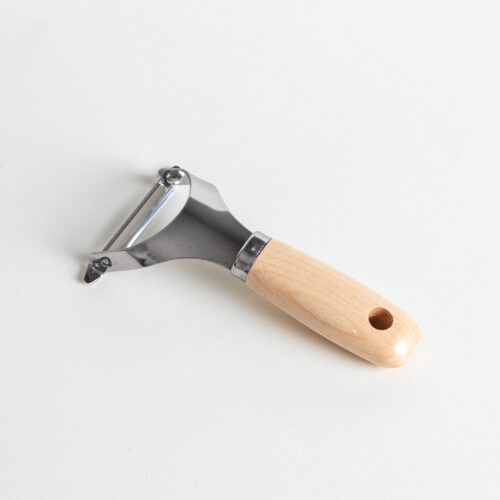
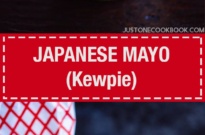
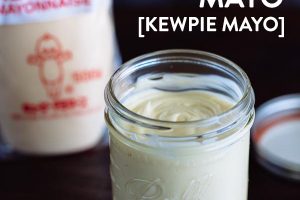
I don’t have trouble with MSG and would prefer to use it. Would you substitute the same amount of the dashi?
I second the use of immersion blender, I made Duke’s style Mayo. Your mayonnaise is made faster than you can say it and made so perfectly.
thank you for this and any advice about amount of MSG.
Hi Nancy! Thank you so much for reading Nami’s post and trying her recipe!
MSG enhances the flavor, but we don’t recommend using it in place of Dashi. You can replace a pinch (1/16 teaspoon) of salt with MSG if you like.
We hope this helps!
It took me three tries till it finally came together. If you’re having a hard time, I highly recommend the kenji Lopez method using an immersion blender. If you Google it you’ll find it and it works fantastically. The flavor of this recipe is fabulous.
Hi Strugglin’! Thank you so much for trying Nami’s recipe and sharing your tips with us.
We are glad to hear that you enjoyed the homemade Mayonnaise flavor.
Thank you for your kind feedback! 🙂
Why remove MSG? Japanese have the longest lived of culture and MSG has been a staple of all their food since the 40’s.
as long as true ajinomoto msg (japanese) is used – msg is better than salt. ajinomoto does not harm your body at all.
Hi Trace. Thank you for taking the time to read Nami’s post.
Because the majority of our readers prefer MSG-free products, we are only providing the option for them with homemade recipes. 😉
Some people are allergic to MSG which can often trigger intense migraines; I was hospitalised with one such migraine, after unknowingly eating MSG in a restaurant, despite asking if MSG was used and being told NO.
It is a good idea for Namiko to offer alternatives to some produce.
So you also avoid eating dashi/kombu, miso, soy sauce, Worcestershire sauce, Parmesan cheese, mushrooms, heck even tomatoes? All of these contain free glutamates, which are almost identical to monosodium glutamates. You can easily look it up, that in blind tests and placebo tests side effects from MSG were not present or inconclusive.
There’s evidence of a minority of people having a sensitivity to high levels of the salts (in the chemical sense) but when I see every 5th person attributing their issues to MSG I can’t help but point out that it’s simply unfounded.
Almost identical but not quite. In chemistry, that slight difference makes all the difference.
It’s the equivalent to saying that saturated fats and monounsaturated fats are almost alike.
The issue with MSG is the fact it’s structure is smaller. Because of it’s refined size, the body uptakes it more rapidly than with the full glutamate, which is an issue because there is a delay between recognizing the body has uptaken too much and actually stopping the uptake. It’s the same thing as if you eat too fast, you’ll overeat as the body’s response to fullness is delayed. MSG is naturally easy to over-consume BECAUSE of it’s small molecular size (compared to that of it’s real counterpart – glutamate), which the effects over decades of over-uptake results in the accelerated degeneration of your nerves. This is why it’s regarded as an excitotoxin and is the reason why Japan’s original founders of MSG did not choose to commercialize it in Japan as they saw these deleterious effects on rats they’ve tested it on.
What happened instead were American businessmen that bought the rights and commercialized it to the ubiquitous presence it has today. Ever heard of Parkinson’s? Strong contributing factor.
To clarify: naturally fermented foods have the REAL glutamate. Monosodium glutamate, in other words a sodium salt of glutamate, is a much smaller molecule and is synthetic.
You’ll never find MSG produced in nature, but you will find glutamate (aka glutamic acid) is found in fermented foods like dashi/kombu, soy sayce, miso, etc. Glutamate is wonderful for you. Stay away from monosodium glutamate.
Remember ladies and gents – there are shortcuts in life, but they come with a hidden cost that will manifest itself far into the future
not true, its a myth. There have been thousands of studies that disprove this missinformation from the 60’s. Which was mostly just racism. You’d have to consumer 3+ grams, by itself to experience anything. You might be having a reaction to someting, but theres no such thing as an allergy to msg.
https://www.mountsinai.org/health-library/diseases-conditions/monosodium-glutamate-msg-food-intolerance#:~:text=MSG%20is%20added%20to%20many,well%20as%20by%20insect%20stings
https://health.clevelandclinic.org/is-msg-really-harmful/
So, lets say hypothetically, someone had to double (and subsequently triple) the recipe because they used a cold egg and added oil too fast. Now, that person has 2 quarts of Japanese mayo in their fridge and has no idea how to use that much. What would you suggest?
Hi, Drowning in Kewpie! Thank you for trying Nami’s recipe!
The mayonnaise will last in the refrigerator for about four days, so try a list of recipes that you can use homemade mayonnaise: https://www.justonecookbook.com/#search/q=mayonnaise
Or share/gift the homemade mayonnaise with your friends, families, and neighbors?? We hope everyone can enjoy it! 😉
With some reluctance, I decided to make this today. I thought – no way is it going to work! But I made this, and guess what? It tastes pretty darn close to the real thing. At first the flavor of rice vinegar came through pretty strongly, so I added another teaspoon of sugar and a touch more salt and that seems to have fixed the problem. The mayo came out nice and thick – very good!
Hi Mimi! Thank you for trying Nami’s recipe and sharing your experience with us.
We are so happy to hear this recipe worked for you and enjoyed homemade Japanese Mayonaise!🙂
Happy Cooking!
Third time making this recipe ,works great every time . I usually add a dash of fish sauce just to zing it up a bit .
Hi Marc! We are glad to hear the recipe worked well for you!😊
Thank you for trying Nami’s recipe and sharing your tip!
Hello!
Can this be frozen? There is no way I can eat all of these, so shortly!
Hi Amy! Thank you for trying Nami’s recipe!
Unfortunately, we do not recommend storing it in the freezer.
When Mayonnaise reaches below freezing temperature, the oil and other ingredients will separate when you defrost them.
How about using half of them to make spicy mayo? or use it for other recipes?
https://www.justonecookbook.com/spicy-mayo-recipe
https://www.justonecookbook.com/#search/q=mayonnaise
We hope this helps!
Mine came out very runny ….did I miss something?
Hi Grace, Thank you for trying Nami’s recipe!
The homemade mayonnaise comes together pretty quickly in the food processor or blender. If you mix it too long, the emulsion that brought the spread together is more likely to break. Would you please shorten the processing time next time and see how it goes?
Not a good recipe. WAY too much oil. Standard oil to yolk recipe is 1 cup to 2 yolks, not 1 1/2 cups oil. It’ll never come together as an emulsion using that much oil.
Hi John, We are sorry to hear that this recipe did not work for you.
Please feel free to adjust the oil amount and enjoy the homemade Mayonnaise. 🙂
Actually, one egg yolk is capable of emulsifying up to one liter of oil. Maybe try streaming the oil in slower next time
Ive made this like a dozen times now, It’s 1 1/2 cups of oil with 2 yolks…works just fine for me but I use a stick blender, comes together in like 20 seconds. I use avocado oil and erythritol & allulose so that it’s keto. Works great. Give it a try, just pour everything into a tall narrow container, buzz up with an immersion blender, start with it on the bottom of the container and slowly pull up over about 15swconds. Works great for me everytime and tastes amazing.
Only a high power immersion blender will manage this 😉 I have a famous Swiss brand that does the job well but other brands may fall short of this task 😉😉
Why can’t your recipes be printed?
Hi Jonathan! Thank you for trying Nami’s recipe!
Would you please click the PRINT RECIPE bar on the recipe card? It will direct you to the printing options page.
We hope this helps!
Can I use regular dashi instead of the powder? If so how much?
Hi Matt! Thank you for reading Nami’s post and trying her recipe!
We don’t think dashi would work well with oil. If you prefer other than Dashi powder, try adding the Katsuobushi.
We hope this helps!
Used 1.2 tsp sugar, cant imagine using more. Easy to put all in a container that just fits an immersion blender, room temp, 10 seconds and you have mayo. Never a problem. Great recipe, better than Kenji Lopez-Alts recipe hands down. The Dashi made all the difference. Also used avocado oil for flavor which was mild and much better than veg. oil. Also, I understand CYA but I keep this mayo for weeks in fridge with no decrease in flavor .
it doesn’t last long because we eat it, but way longer than 2-3 days. (as in: we are out of town) Love it. Would never adulterate with Miracle whip.
this is the most flavorful mayo I have ever made. hard not to eat it all right away. thank you for
this recipe, it is so easy it begs the question why in the world would you go with store bought?
Hi Cindy! Nami and JOC team are so happy to hear you enjoyed this recipe!
Thank you very much for trying Nami’s recipe and sharing your experience and thought.
Happy Cooking!
Konichiwa Nami! I found this recipe to be quite simple, having made real mayo many times in the past. Curiously, I found that, believe it or not, good ol’ Miracle Whip” salad dressing will serve as a substitute for real Kewpie Mayo, although, as you say, it uses white vinegar, so it can be a bit aggressive in flavor… it’s not for EVERY dish that calls for Kewpie, but it’ll work in a pinch ( for me, anyway… close my eyes tight, click my heels together three times, and keep saying.. it KINDA tastes like Kewpie!
Peace and “Itadake masu!”
Hi Paul! Thank you very much for trying Nami’s recipe!
Did you use rice vinegar? The rice vinegar is milder than white vinegar, and the homemade mayo might taste more close to Kewpie Mayo.
We hope you will give it a try with rice vinegar or apple cider vinegar next time. We hope this helps!
Thanks for all your recipes! I make mayo a lot, always with some mustard, lemon juice and egg yolks. I will try with Dashi next time, or perhaps some dried fish powder. Usually I prefer to whisk it by hand, It gives me more control on the emulsification. With the food processor I sometimes end up with a thin liquid…
BR, Kristin
Hi Kristian! Thank you very much for reading Nami’s post and sharing your cooking experience with us! 🙂
This is one of your recipes that wasn’t great for me. I know how to make mayonnaise, I made your recipe. It just didn’t cut it in the flavor dept. The consistency was good tho’.
Hi Surati! We are sorry to hear the taste wasn’t your favorite.
We hope you adjust the ingredient and enjoy the homemade Mayonnaise!
Once you find a good balance, homemade would be the best taste!🙂
Thank you for trying Nami’s recipe.